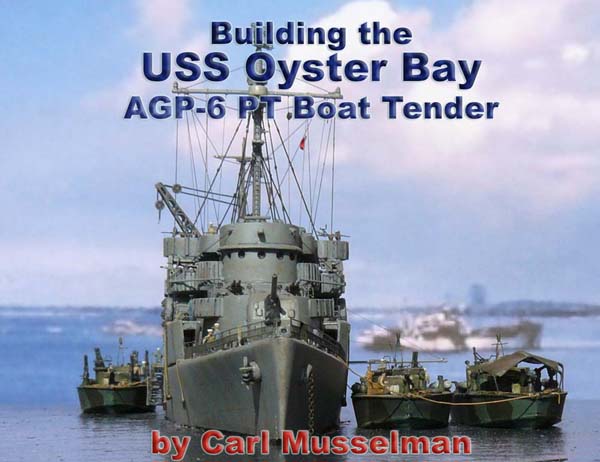
 |
| page 1 of 2 |
| Reference and Inspiration Photos | ||||||
|
||||||
| Derived from the USS Barnegat Class Seaplane Tender Small (AVP) | ||||||
NavSource.org |
||||||
| Modified 1/350 USS Mackinac AVP-13 Resin Model Kit by Iron Shipwrights. | ||||||
| The Iron Shipwright, Inc. 1/350 scale resin kit is the only model that I have found of this obscure class of little ships. I am most grateful, to them, for even considering making a kit of the USS Barnegat class AVPs. My father served on the USS Duxbury Bay AVP-38 and that was the first model that made from this kit. The second model that I used this kit for was that of the USCGC Bering Strait WHEC-382, formerly the USS Bering Strait AVP-34. | 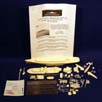 |
|||||
| Only the larger pieces, and major feature pieces, of this kit were used in this build; i.e. hull, superstructure, stack, crane, boats, gun tubs. Many of the smaller pieces such as guns, search lights, etc. were not clean castings and were rather fragile when trying to clean them up. Many after-market pieces were substituted for these smaller pieces. The photo-etched railings for the main deck area are a most welcome and well done feature of the kit. The depth charge racks (not used on previous builds) were rather simple and needed to be modified. By using extra depth charge racks from leftover PE sprues I was able to make a bottom for these depth charge racks. |  |
|||||
| Cutting the Hull to the Waterline | ||||||
| The first step of this particular build was to cut the hull piece to the waterline. After positioning the waterline properly on the hull with masking tape, I drew a line to mark it and removed the tape. I then constructed a wooden jig where this waterline mark lined up, at a slight angle) with the edge of the base to the jig. This edge would slide adjacent to the blade on my band saw and the opposite edge of the jig would ride against the guide fence of the band saw. Because the hull section of this particular model has a flat top (the O1 deck is level and with no superstructure features on it) I was able to fasten the piece to the jig with screws after drilling holes in the wooden jig and the top of the resin hull piece. With the hull at a ninety degree angle to the jig screw block and the jig positioned next to the blade and snug against the guide fence, the entire jig and the model are slid through the saw. It worked rather well and I have done this same technique for other modelers who have this same kit and who want to build them as waterline models. |  |
|||||
 |
||||||
 |
||||||
 |
||||||
 |
||||||
| Aft Superstructure and Fantail - Modifications and Details | ||||||
| I have obtained drawings, from micro film, from the National Archives that include plans for many of the variants of the Barnegat class AVPs, including the AGPs. It was with these drawings that I have been able to more accurately convert this kit into an AGP. |  |
|||||
| When the Seaplane Tender (AVP) was being designed and converted
to a PT Boat Tender (AGP) it was necessary to have additional work shops
for the PT Boat engines and their torpedoes. These shops were placed
aft of the boat crane on the main deck.
After the hull was cut to the waterline and unneeded details were removed from the model’s deck, I started on the extended superstructure aft of the boat crane using Evergreen styrene plastic stock. |
 |
|||||
 |
||||||
 |
||||||
 |
||||||
| There are torpedo splinter shields on most of the ships
of the Barnegat class, on the main deck, outboard the forward superstructure,
port and starboard. On the AGPs, there were additional torpedo splinter
shields added outboard the engine and torpedo repair shops along a portion
of this extended aft superstructure. Torpedoes were stowed inboard
of these splinter shields, both on the AVPs (for seaplanes) and on the
AGPs (for PT Boats).
The “slots” in the O1 deck, atop the repair shops, allowed for the crane to lift the torpedoes (and engines) from this main deck area. There were also lumber storage lockers located port and starboard on this O1 deck. These features were a little different for the USS Mobjack AGP-7, which had a more different features than the other three AGPs of this class. |
 |
|||||
 |
||||||
 |
||||||
 |
||||||
| After this structure was in place and watertight doors positioned, details were added to the decks and bulkheads; e.g. scratch built smoke screen generators, roller chock, winch (BFM), chocks and bitts (Paper Lab & Dragon Models), 5” practice loader (Dragon Models), lockers, stowed davits, fire hoses (L’Arsenal), vent louvers, etc. |  |
|||||
 |
||||||
 |
||||||
| Pilot House and Forward
Superstructure –
Modifications and Details |
||||||
| Moving on from the aft portion of the ship to the forward superstructure, many modifications had to be made to the kit’s intended portrayal of the USS Mackinac AVP-13. |  |
|||||
| Firstly, the number of bridge windows had to be changed from nine to only seven. So these were filled in with bondo and re-drilled for the USS Oyster Bay. |  |
|||||
| Secondly, the windscreen, sponson shields, and bulwark around the bridge
area had to be removed in order to re-create it in the AGP configuration.
Thirdly, the AGPs did not have a “step down” from the forward pilot house top, aft to the navigation / chart house top like on the AVPs. This feature was removed by cutting the O2 deck piece just behind the pilot house, sanding down the top of the O1 deck piece, and re-assembling them in the right configuration. |
 |
|||||
| It was at this point that I wished that I had thought of the idea of portraying some of the doors in their open positions. This became almost impossible to do once that this bridge area was complete with its new bulwark and sponsons, etc. It was hot at Leyte Gulf in November of 1944 and I’m sure that most, if not all, water tight doors were open to let any breeze some through. |  |
|||||
 |
||||||
| It was with this drawing and reference photographs that I was able to re-create the proper arrangement of the bulwark and sponsons and decking around the bridge area using Evergreen styrene plastic stock. |  |
|||||
 |
||||||
 |
||||||
 |
||||||
 |
||||||
| From this valuable drawing (It is rare to find reference photos of this portion of any of the Barnegat class AVPs and AGPs.) I was able to replicate the fire control, lookout, search light and 20mm gun arrangement atop the pilot and chart house. |  |
|||||
| I started with the “figure eight” shaped platform in the center of the deck which supported the range finder and one Mk51 gun director for the 5” gun. Another platform was for the gun director “computer”. And then two additional Mk51 directors (YMW) for the forward 40mm guns, pelorous’ (Paper Lab), lookout stations (L’Arsenal), 20mm guns (L’Arsenal) and ready ammo storage lockers. And I added wind screen canvas on the railings on the gun director platforms by spreading white glue between the rails and stanchions. |  |
|||||
 |
||||||
 |
||||||
 |
||||||
| Around the lower sections of the bridge area, I installed cargo loading booms, life rafts (Voyager Models), life rings (L’Arsenal”) and gas cylinder bottles (L’Arsenal). |  |
|||||
| Twin Dual 40mm Bofors Gun Mounts |  |
|||||
| In place of the usual 5” gun turret or Quad 40mm gun mount
in the #2 weapons position, the AGPs had Twin Dual 40mm gun mounts located
here. Also, the edge of the O1 deck, in this area, was cut back,
inboard, and back towards the superstructure.
Using two gun tubs from L’Arsenal as the foundation of this feature, I cut and applied Evergreen styrene stock in the shape of the tubs’ shields, added ammo racks (L’Arsenal) and depicted them covered with canvas using pieces of black decal stripes and then painting over them. The two Dual 40mm guns are from L’Arsenal. |
 |
|||||
 |
||||||
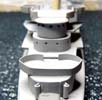 |
||||||
 |
||||||
| The ledge just forward of the gun tub was present on the other three AGPs of this class but, the USS Oyster Bay had this ledge enclosed and with two hatches atop of it for passing ammunition. |  |
|||||
 |
||||||
 |
||||||
| Forward Amidships – Modifications and Details | ||||||
| Once again, using copies of micro film drawings from the National Archives, I modified the forward amidships area of the kit to be more accurate for the AGP. | 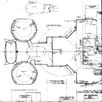 |
|||||
 |
||||||
| Starting with the foundation structure around the base of the stack, and chiseling out a corner of the molded-in compartment forward of the stack, I then added a “vegetable locker” (port side), water breakers storage rack (aft), scratch built and cast resin ventilation blowers (port and starboard), and mushroom shaped “galley vents” (Dragon Models). |  |
|||||
 |
||||||
 |
||||||
 |
||||||
 |
||||||
|
Then the decking around the stack was added and the gun director tower completed using the resin piece supplied with the kit and adding brass angled stock for the legs and brass rod for the angled supports. Two Mk51 gun directors, from YMW, were mounted atop the tower with canvas covered railings around its perimeter. Gas cylinder bottles (L’Arsenal) were depicted in the drawings and I added these in the indicated places even though some of them won’t be seen on the completed model. The micro film drawings included a painting schedule for the color of the oxygen and acetylene gas bottles. That was nice to have. The stack’s exhausts were drilled out and a band wrapped around it, flood lights attached, and a photo-etched stack platform (Dragon Models) was attached with the ship’s horn and steam whistle attached. Later on, the stack’s stays were added using steel guitar strings. |
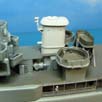 |
|||||
 |
||||||
 |
||||||
|
Additional details in this area include the canvas covered railings, ship’s bell (BMK), compass / binnacle (Paper Lab), winch (BFM), signal flag bags (Dragon Models) and cable reels (L’Arsenal). The 40mm ammo racks in the kit-supplied gun tubs are from L’Arsenal and portrayed as being covered with canvas, and the Dual 40mm gun mounts, that go in the tubs, are from L’Arsenal, too. |
 |
|||||
 |
||||||
| Aft Amidships – Modifications and Details | ||||||
| The aft amidships area had several modifications that had to be made including relocating 20mm ammo ready lockers, addition of 20mm gun mounts (L’Arsenal) and shields, mooring line and cable / hose reels, scratch built and resin-cast engine room ventilation stack, sky lookout stations and 5” gun gunpowder storage lockers. |  |
|||||
 |
||||||
 |
||||||
 |
||||||
 |
||||||
| The molded-in small boat cradles were scraped off (along with many other molded-in features) and their PE cradles were attached to the 36’ Personnel Launches prior to mounting them to the deck. One launch has been depicted with a canvas cover on it. I filled the launch with Testors white putty and then covered it with black decal striping and Solvaset and then painted it. The other launch has been detailed with crewmen (L’Asrenal) readying it for launching by the boat crane. |  |
|||||
 |
||||||
 |
||||||
 |
||||||
 |
||||||
 |
||||||
| The boat crane was enhanced with access hatches (L’Arsenal), ladders, railings, yardarm and rigging. The crane’s PE boom came with the kit. I added PE hand wheels to the boom’s pulleys for a little more detail. |  |
|||||
 |
||||||
| Aft of the boat crane is an open mount 5”/38 cal gun from L’Arsenal. I have depicted this as covered with a canvas tarp. |  |
|||||
| Main Deck - Details | ||||||
| One of the obvious identifying features of this class of
ships are the Torpedo Splinter Shields located outboard the forward superstructure,
at the main deck, port and starboard.
The Iron Shipwright, Inc. (ISW) kit of the USS Mackinac AVP-13, an early
member of the Barnegat class AVPs, does not include parts for this feature.
The early ships of this class were not built with these. They were
added later on.
I scratch built these shields for my first build of this kit into the USS Duxbury Bay AVP-38. I also had to scratch build a version of them for my model of the USCGC Bering Strait WHEC-382. While scratch building another set of the shields for the USS Oyster Bay, I asked a friend to cast more copies of the master in resin, for me, for future intended builds from this ISW kit. |
 |
|||||
 |
||||||
| Starting out with a piece of Evergreen styrene channel
stock, I cut and formed it into shape and added a block on the back of
it. The top edge of this “block” and the lower “lip” of the channel
stock were sized and shaped so as to “wedge” tightly between the main deck
and the O1 deck on the model. This all depending on the thickness
of the O1 deck piece which has to be sanded thinner to the correct thickness
in order to match the fit to other features of the hull / main deck piece.
The master torpedo splinter shield piece was shaped so that it will work for both the port and the starboard side. |
 |
|||||
 |
||||||
| All of the doors and portholes that were molded into the kit were removed or filled in and the drawings were used to position them in the proper locations for the AGP version. Some doors, here, were depicted in their open position by drilling and chiseling out the resin. The doors are from L’Arsenal. |  |
|||||
 |
||||||
|
The rails and stanchions along the main deck are one-piece PE sections that came with the kit. Although the spacing between the stanchions aren’t exact to the real ships (the PE ones are more equally spaced), these pieces are most welcome and fit well. |
 |
|||||
| The AGPs had torpedo handling trolleys that ran on tracks
along the port and starboard main deck. I have depicted a torpedo
on a trolley on the starboard side main deck.
The details on the forecastle include chocks and bitts, a bow chock and an open chock and starboard side anchor (all from a 1/350 Dragon Models destroyer kit), capstans from a 1/700 scale set from BFM (the larger 1/700 scale capstans were a good match for small 1/350 scale capstans), deck hatches from Paper Lab, and a 5”/38 cal gun turret from Corsair Armada Productions. I depicted my 5” gun turret with the doors open and drilled, and chiseled, a hole through the resin turret. (The port side anchor is not attached because the ship will be portrayed at anchor in a diorama with the port anchor lowered.) |
 |
|||||
 |
||||||
 |
||||||
 |
||||||
| Mast and Rigging | ||||||
| The micro film drawings included wonderful plans for the masts, shrouds, stays, and antenna rigging features. |  |
|||||
 |
||||||
 |
||||||
|
At some time between the New Guinea and Leyte Gulf campaigns, an Australian fighter plane pilot was showing off and got too, close to the USS Oyster Bay and clipped the antenna wires and stack mast between the foremast and the mainmast (crane) damaging the stack’s radar mast and other equipment in that area of the amidships. The USS Oyster Bay then went into repairs and the stack mast was removed and the foremast modified to support the SA radar. |
 |
|||||
 |
||||||
 |
||||||
 |
||||||
| The foremast was constructed from brass rod and styrene stock. The SA Radar is from L’Arsenal. The dome radar came with the kit. The stays and shrouds were attached from the lower, inner and outer stays up towards the upper, inner and outer stays and shrouds using lengths of steel guitar stings. The halyards and antennas are painted, invisible thread. The foremast depicts the Bravo flag at half way to depict suspended refueling operations, along with the UNREP “balloon”, and the third substitution pennant indicating the commanding officer is absent. |  |
|||||
| The ensign is hoisted on the mainmast (crane). On the real ship, the yardarm on the crane is mounted to a bearing assembly which keeps the yardarm perpendicular to the centerline of the ship as the crane rotates below. It took me a little while to figure this one out. |  |
|||||
More
of Carl Musselman 's work.
Updated 2010

© ModelWarships.com